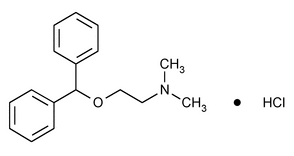Diphenhydramine Hydrochloride
(dye'' fen hye' dra meen hye'' droe klor' ide).
Ethanamine, 2-(diphenylmethoxy)-N,N-dimethyl-, hydrochloride.
2-(Diphenylmethoxy)-N,N-dimethylethylamine hydrochloride
» Diphenhydramine Hydrochloride contains not less than 98.0 percent and not more than 102.0 percent of C17H21NO·HCl, calculated on the dried basis.
Packaging and storage—
Preserve in tight, light-resistant containers. Store at room temperature.
Identification—
A:
It meets the requirements under Identification—Organic Nitrogenous Bases  181
181 .
.
B:
The retention time of the major peak in the chromatogram of the Assay preparation corresponds to that in the chromatogram of the Standard preparation, as obtained in the Assay.
C:
It responds to the tests for Chloride  191
191 .
.
Melting range  741
741 :
between 167
:
between 167 and 172
and 172 .
.
Loss on drying  731
731 —
Dry it at 105
—
Dry it at 105 for 3 hours: it loses not more than 0.5% of its weight.
for 3 hours: it loses not more than 0.5% of its weight.
Residue on ignition  281
281 :
not more than 0.1%.
:
not more than 0.1%.
Assay—
Mobile phase—
Prepare a solution of acetonitrile, water, and triethylamine (50:50:0.5), adjust with glacial acetic acid to a pH of 6.5, filter, and degas. Make adjustments if necessary (see System Suitability under Chromatography  621
621 ).
).
Standard preparation—
Dissolve an accurately weighed quantity of USP Diphenhydramine Hydrochloride RS in water to obtain a solution having a known concentration of about 0.5 mg per mL.
Assay preparation—
Transfer about 25 mg of Diphenhydramine Hydrochloride, accurately weighed, to a 50-mL volumetric flask, dissolve in and dilute with water to volume, mix, and filter.
System suitability solution—
Dissolve about 5 mg of benzophenone in 5 mL of acetonitrile, dilute with water to 100 mL, and mix. Transfer 1.0 mL of this solution and 5 mg of diphenhydramine hydrochloride to a 10-mL volumetric flask, dilute with water to volume, and mix.
Chromatographic system (see Chromatography  621
621 )—
The liquid chromatograph is equipped with a 254-nm detector and a 4.6-mm × 25-cm column that contains packing L10. The flow rate is about 1 mL per minute. Chromatograph the System suitability solution, and record the peak responses as directed for Procedure: the resolution, R, between the benzophenone and diphenhydramine peaks is not less than 2.0. Chromatograph replicate injections of the Standard preparation, and record the peak responses as directed for Procedure: the relative standard deviation is not more than 2.0%; and the tailing factor for the diphenhydramine hydrochloride peak is not more than 2.0.
)—
The liquid chromatograph is equipped with a 254-nm detector and a 4.6-mm × 25-cm column that contains packing L10. The flow rate is about 1 mL per minute. Chromatograph the System suitability solution, and record the peak responses as directed for Procedure: the resolution, R, between the benzophenone and diphenhydramine peaks is not less than 2.0. Chromatograph replicate injections of the Standard preparation, and record the peak responses as directed for Procedure: the relative standard deviation is not more than 2.0%; and the tailing factor for the diphenhydramine hydrochloride peak is not more than 2.0.
Procedure—
Separately inject equal volumes (about 10 µL) of the Standard preparation and the Assay preparation into the chromatograph, record the chromatograms, and measure the responses for the major peaks. Calculate the quantity, in mg, of C17H21NO·HCl in the portion of Diphenhydramine Hydrochloride taken by the formula:
50C(rU / rS)
in which C is the concentration, in mg per mL, of USP Diphenhydramine Hydrochloride RS in the Standard preparation; and rU and rS are the peak responses obtained from the Assay preparation and the Standard preparation, respectively.
Auxiliary Information—
Please check for your question in the FAQs before contacting USP.
| Topic/Question | Contact | Expert Committee |
|---|---|---|
| Monograph | Domenick Vicchio, Ph.D.
Senior Scientific Liaison 1-301-998-6828 |
(SM42010) Monographs - Small Molecules 4 |
| Reference Standards | RS Technical Services 1-301-816-8129 rstech@usp.org |
USP35–NF30 Page 2931
Pharmacopeial Forum: Volume No. 37(3)

